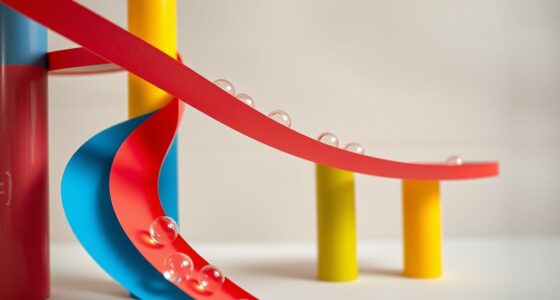To set up a Reggio-inspired atelier, organize a warm, inviting space with natural light and calming colors. Keep materials accessible at children’s height and include open-ended resources like textured fabrics, natural objects, and artistic supplies. Encourage child-led exploration by creating clearly defined areas for different activities. Focus on sensory-rich materials that promote curiosity and creativity. If you continue exploring, you’ll discover how to nurture independence, confidence, and a lifelong love for discovery in your space.
Key Takeaways
- Design an inviting, organized environment with natural light, calming colors, and accessible shelves for child independence.
- Incorporate open-ended, sensory-rich materials like textured fabrics, natural objects, and versatile art supplies.
- Create clearly defined exploration areas to encourage autonomous choice and focused engagement.
- Arrange materials to promote diverse uses and inspire creativity, supporting varied interests and inquiry.
- Foster a welcoming space that nurtures curiosity, confidence, and a love for discovery through child-led exploration.

A Reggio-inspired atelier offers a dynamic space where children’s natural curiosity and creativity take center stage. It’s a place designed to inspire exploration and foster a love for learning by giving children the freedom to direct their own experiences. One of the core principles here is child-led learning, which means you create an environment that invites children to pursue their interests at their own pace. Instead of imposing rigid activities, you provide open-ended materials and resources that allow children to choose what to explore. As they engage, they develop critical thinking, decision-making skills, and a sense of ownership over their learning journey. This approach not only boosts confidence but also encourages independence.
Sensory exploration plays a essential role in this setting. You’ll want to include a variety of tactile, visual, auditory, and even olfactory materials that invite children to use their senses. Think of textured fabrics, natural objects like stones and leaves, colorful paints, and musical instruments. These materials are not just for play—they’re tools for discovery. When children manipulate different textures or respond to various sounds, they deepen their understanding of the world around them. As they touch, smell, listen, and observe, they build neural connections that support cognitive development. By offering rich sensory experiences, you help children develop focus, patience, and an appreciation for the complexity of their environment.
Setting up the space thoughtfully is key. Keep the environment organized yet inviting, with clearly defined areas for different types of exploration—art, science, dramatic play, and quiet reflection. Use natural light and calming colors to create a welcoming atmosphere. Place accessible shelves at child height so children can independently select materials, fostering autonomy. Incorporate a variety of open-ended resources that can be used in multiple ways, encouraging creativity and problem-solving. As children move through the space, they’ll naturally gravitate toward activities that interest them most, reinforcing their intrinsic motivation to learn.
Frequently Asked Questions
How Do I Adapt the Atelier for Different Age Groups?
To adapt the atelier for different age groups, you should select age-appropriate materials that match their developmental stages. Create flexible workspaces that can be easily rearranged to suit various activities and ages. Encourage exploration and creativity by providing varied tools and open-ended projects. Adjust the level of supervision and guidance based on age, allowing younger children more hands-on support while fostering independence in older children.
What Safety Measures Are Essential in a Creative Space?
You should implement hazard prevention by removing sharp tools and securing unstable furniture. Enforce safety protocols like supervising children closely, using age-appropriate materials, and teaching proper tool use. Regularly inspect the space for potential hazards, guarantee exits are clear, and keep first aid supplies accessible. By actively maintaining safety measures, you create a secure environment that fosters creative exploration without unnecessary risks.
How Can I Incorporate Local Cultural Materials?
You can incorporate local cultural materials by sourcing local craft items and integrating them into your space. Use these materials to inspire cultural storytelling, allowing children to connect with their heritage through art and play. Display traditional crafts, incorporate local symbols, and encourage children to share stories behind the materials. This approach enriches their understanding of community, culture, and identity while fostering creativity and respect for local traditions.
What Is the Ideal Size for a Reggio-Inspired Atelier?
Think of your atelier as a cozy garden where ideas bloom; ideally, it should be around 150 to 300 square feet. You want enough space for open-ended exploration without feeling cramped. Focus on smart space organization and natural lighting, which act like sunbeams nurturing creativity. By balancing these elements, you create an inviting environment where children thrive and their imaginations flourish effortlessly.
How Do I Manage Ongoing Supply and Material Updates?
You manage ongoing supply and material updates by maintaining effective inventory management, tracking what’s used and what’s needed. Regularly review your supplies, and source sustainable materials whenever possible to promote eco-friendly practices. Build relationships with local vendors and establish a routine for replenishing supplies, ensuring your atelier remains well-stocked with fresh, inspiring materials. This proactive approach keeps your creative space vibrant and ready for ongoing exploration.
Conclusion
Now, picture your atelier as a vibrant garden, where colors bloom and ideas sprout like fresh leaves. As you nurture this space, it becomes a sanctuary of curiosity and growth, inviting children to explore and imagine freely. With each brushstroke and every new discovery, you’re cultivating a world of endless possibilities. Keep this creative haven alive, and watch it transform into a magical landscape where wonder and learning flourish together.










